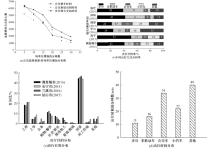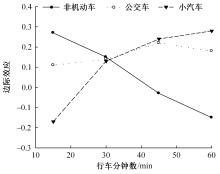Journal of Jilin University(Engineering and Technology Edition) ›› 2024, Vol. 54 ›› Issue (2): 461-468.doi: 10.13229/j.cnki.jdxbgxb.20220312
Travel mode choice in small and media sized city based on random parameters Logit model
Yan ZHUANG1( ),Chun-jiao DONG1(
),Chun-jiao DONG1( ),Xue-yu MI2,Xiao-yu ZHANG1,Jing WANG1
),Xue-yu MI2,Xiao-yu ZHANG1,Jing WANG1
- 1.Key Laboratory of Transport Industry of Big Data Application Technologies for Comprehensive Transport,Beijing Jiaotong University,Beijing 100044,China
2.Tangshan Key Laboratory of Air-Ground Intelligent Transportation,North China University of Science and Technology,Tangshan 063210,China
CLC Number:
- U491.1
| 1 | Hu H, Xu J, Shen Q, et al. Travel mode choices in small cities of China: a case study of Changting[J]. Transportation Research part D: Transport and Environment, 2018, 59: 361-374. |
| 2 | 覃栩曈. 中小城市出行即服务体系规划设计[D].桂林:桂林电子科技大学建筑与交通工程学院,2021. |
| Tan Xu-tong. Planning and design of mobility as a service system in small and medium-sized cities[D]. Guilin: School of Architecture and Transportation Engineering, Guilin University of Electronic Technology,2021. | |
| 3 | 阿东. 基于改进型MNL模型的中小城市居民出行交通方式研究[D].长沙:湖南大学土木工程学院,2019. |
| Dong A.Research on travel modes of residents in smal and medium-sized cities based on improved MNL mode[D].Changsha:College of Civil Engineering, Hunan University,2019. | |
| 4 | McFadden D, Train K. Mixed MNL models for discrete response[J]. Journal of Applied Econometrics, 2000, 15(5): 447-470. |
| 5 | Koppelman F S, Pas E I. Travel-choice behavior: Models of perceptions, feelings, preference, and choice[J]. Transportation Research Record, 1980(765): 1-13. |
| 6 | 叶玉玲,韩明初,陈俊晶.基于出行链的城际旅客出行方式选择行为[J].同济大学学报:自然科学版,2018,46(9):1234-1240. |
| Ye Yu-ling, Han Ming-chu, Chen Jun-jing.Intercity passenger travel mode choice behavior based on trip chain[J]. Journal of Tongji University (Natural Science),2018,46(9):1234-1240. | |
| 7 | 程琳,栾鑫,邓卫,等. 特大城市居民出行方式选择行为的混合Logit模型[J]. 吉林大学学报:工学版, 2018, 48(4):1029-1036. |
| Cheng Lin, Luan Xin, Deng Wei, et al. Mixed Logit model for understanding travel mode choice behavior of megalopolitan residents[J]. Journal of Jilin University (Engineering and Technology Edition) 2018, 48(4):1029-1036. | |
| 8 | Ding C, Wang D, Liu C, et al. Exploring the influence of built environment on travel mode choice considering the mediating effects of car ownership and travel distance[J]. Transportation Research Part A: Policy and Practice, 2017, 100: 65-80. |
| 9 | 刘建荣,郝小妮.基于随机系数Logit模型的市内出行方式选择行为研究[J].交通运输系统工程与信息,2019,19(5):108-113. |
| Liu Jian-rong, Hao Xiao-ni.Travel mode choice in city based on random parameters logit model[J]. Journal of Transportation Systems Engineering and Information Technology, 2019,19(5):108-113. | |
| 10 | Escobari D. Airport, airline and departure time choice and substitution patterns: an empirical analysis[J]. Transportation Research Part A: Policy and Practice, 2017, 103: 198-210. |
| 11 | 唐立,邹彤,罗霞,等.基于混合Logit模型的网约车选择行为研究[J].交通运输系统工程与信息,2018,18(1):108-114. |
| Tang Li, Zou Tong, Luo Xia, et al. Choice behavior of taxi-hailing based on mixed-logit model[J]. Journal of Transportation Systems Engineering and Information Technology, 2018,18(1):108-114. | |
| 12 | Shamshiripour A, Golshani N, Shabanpour R, et al. Week-long mode choice behavior: dynamic random effects logit model[J]. Transportation Research Record, 2019, 2673(10): 736-744. |
| 13 | 赵淑芝,赵贝.多因素影响下的城市居民出行行为时间价值[J].吉林大学学报,工学版,2011,41(1):46-50. |
| Zhao Shu-zhi, Zhao Bei.Value of travel time of urban resident under multifactor influence[J]. Journal of Jilin University (Engineering and Technology Edition), 2011,41(1):46-50. | |
| 14 | 张晨阳. 考虑潜在变量的西安居民短距离出行方式选择研究[D].西安:长安大学运输工程学院,2019. |
| Zhang Chen-yang. Research on short-distance travel mode choice behavior of Xi'an residents considering potential variables[D].Xian: College of Transportation Engineering, Chang'an University,2019. | |
| 15 | Khan N A, Habib M A. Understanding variations in activity-based vehicle allocation decisions: a latent segmentation-based random parameter logit modeling approach[J]. Transportation Research Procedia, 2020, 48: 1505-1525. |
| [1] | Zhuang-lin MA,Shan-shan CUI,Da-wei HU,Jin WANG. Travel mode choice of traditional car travelers after implementation of driving restriction policy [J]. Journal of Jilin University(Engineering and Technology Edition), 2023, 53(7): 1981-1993. |
| [2] | Zhi-wei LIU,Zheng-yun SONG,Jian-rong LIU. Impact of shared autonomous vehicles on choice of subway station connection methods [J]. Journal of Jilin University(Engineering and Technology Edition), 2023, 53(12): 3424-3431. |
| [3] | Bao-feng SUN,Yuan JIANG,Li-li ZHENG,Wan-kun CUI,Xin-xin REN. Modified design model of maintenance network for urban rail transit system with variable radius covering [J]. Journal of Jilin University(Engineering and Technology Edition), 2020, 50(2): 526-534. |
| [4] | HOU Xian-yao, CHEN Xue-wu. Use of public transit information market segmentation based onattitudinal factors [J]. 吉林大学学报(工学版), 2018, 48(1): 98-104. |
|
||



